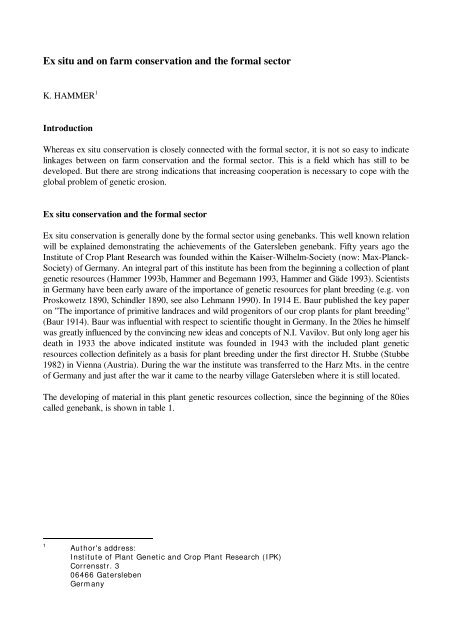Integration of Conservation Strategies of Plant Genetic ... - Genres
Integration of Conservation Strategies of Plant Genetic ... - Genres
Integration of Conservation Strategies of Plant Genetic ... - Genres
Create successful ePaper yourself
Turn your PDF publications into a flip-book with our unique Google optimized e-Paper software.
Ex situ and on farm conservation and the formal sector<br />
K. HAMMER 1<br />
Introduction<br />
Whereas ex situ conservation is closely connected with the formal sector, it is not so easy to indicate<br />
linkages between on farm conservation and the formal sector. This is a field which has still to be<br />
developed. But there are strong indications that increasing cooperation is necessary to cope with the<br />
global problem <strong>of</strong> genetic erosion.<br />
Ex situ conservation and the formal sector<br />
Ex situ conservation is generally done by the formal sector using genebanks. This well known relation<br />
will be explained demonstrating the achievements <strong>of</strong> the Gatersleben genebank. Fifty years ago the<br />
Institute <strong>of</strong> Crop <strong>Plant</strong> Research was founded within the Kaiser-Wilhelm-Society (now: Max-Planck-<br />
Society) <strong>of</strong> Germany. An integral part <strong>of</strong> this institute has been from the beginning a collection <strong>of</strong> plant<br />
genetic resources (Hammer 1993b, Hammer and Begemann 1993, Hammer and Gäde 1993). Scientists<br />
in Germany have been early aware <strong>of</strong> the importance <strong>of</strong> genetic resources for plant breeding (e.g. von<br />
Proskowetz 1890, Schindler 1890, see also Lehmann 1990). In 1914 E. Baur published the key paper<br />
on "The importance <strong>of</strong> primitive landraces and wild progenitors <strong>of</strong> our crop plants for plant breeding"<br />
(Baur 1914). Baur was influential with respect to scientific thought in Germany. In the 20ies he himself<br />
was greatly influenced by the convincing new ideas and concepts <strong>of</strong> N.I. Vavilov. But only long ager his<br />
death in 1933 the above indicated institute was founded in 1943 with the included plant genetic<br />
resources collection definitely as a basis for plant breeding under the first director H. Stubbe (Stubbe<br />
1982) in Vienna (Austria). During the war the institute was transferred to the Harz Mts. in the centre<br />
<strong>of</strong> Germany and just after the war it came to the nearby village Gatersleben where it is still located.<br />
The developing <strong>of</strong> material in this plant genetic resources collection, since the beginning <strong>of</strong> the 80ies<br />
called genebank, is shown in table 1.<br />
1<br />
Author's address:<br />
I nstitute <strong>of</strong> <strong>Plant</strong> <strong>Genetic</strong> and Crop <strong>Plant</strong> Research (I PK)<br />
Corrensstr. 3<br />
06466 Gatersleben<br />
Germ any










